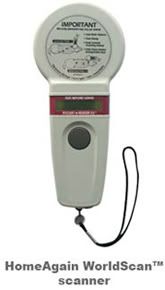 After pet identification tags, getting a pet microchipped is a great step toward getting your pet home if he or she becomes lost or escapes during a disaster.
After pet identification tags, getting a pet microchipped is a great step toward getting your pet home if he or she becomes lost or escapes during a disaster.
The rice sized chip is inserted by a veterinarian under the pet’s skin and when scanned, it reveals the name and address of the owner.
Until recently the big glitch was that some of the scanners used to search for microchips would not read all of the microchips on the market because the different frequencies makes brands incompatible with many of the readers.
 Last year the HomeAgain Universal WorldScan was released. (A Universal WorldChip was released this year.) The microchip scanner can read all the microchip frequencies (125 kHz, 128 kHz, 134.2 kHz) currently on the market.
Last year the HomeAgain Universal WorldScan was released. (A Universal WorldChip was released this year.) The microchip scanner can read all the microchip frequencies (125 kHz, 128 kHz, 134.2 kHz) currently on the market.
In addition, a MiniTracker Pro microchip scanner was introduced by Avid Identification Systems Inc. The MiniTracker Pro can read both encrypted or unencrypted (125 kHz, 134.2 kHz) microchips.
Another problem facing those seeking owners for lost pets is that the shelters and veterinary clinics also have to check multiple databases to find the information from the implanted microchips.
The American Veterinary Medical Association (AVMA) suggested a change and is urging that a network of links between databases is created so that the process is simplified.
In the meantime, HomeAgain issued a US Pet Recover Service Center Chart to customers. The chart lists the names of other microchip manufacturers along with their phone numbers.
This is an essential guide because it includes information on the different chip frequencies and how they appear when scanned—which helps identify what database to search in order to reunite the pet with his or her family.


Is there any place I can search for a pet by name to see it it is micro chipped. Our neighbor gave us a cat and it’s name then moved unexpectedly. More like disappeared. We love the cat and want to keep it but we also want to know more information about him. Vaccinations, Vet’s Name, Age, etc.
Can you help?
Thanks
Terry
Take the pet to be scanned at your veterinarian’s office or an animal shelter. They can pull up the number and any information associated with it.